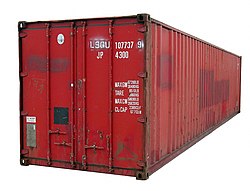Intermodal container: Difference between revisions
Pat Palmer (talk | contribs) (WP Attribution) |
Pat Palmer (talk | contribs) mNo edit summary |
||
| Line 23: | Line 23: | ||
Invented in the early 20th century, 40-foot intermodal containers proliferated during the 1960s and 1970s under the [[containerization]] innovations of the American shipping company [[SeaLand]]. Like [[cardboard box]]es and [[pallet]]s, these containers are a means to bundle cargo and goods into larger, [[Unit load|unitized loads]] that can be easily handled, moved, and stacked, and that will pack tightly in a ship or yard. Intermodal containers share a number of construction features to withstand the stresses of intermodal shipping, to facilitate their handling, and to allow stacking. Each has a unique [[ISO 6346]] reporting mark. | Invented in the early 20th century, 40-foot intermodal containers proliferated during the 1960s and 1970s under the [[containerization]] innovations of the American shipping company [[SeaLand]]. Like [[cardboard box]]es and [[pallet]]s, these containers are a means to bundle cargo and goods into larger, [[Unit load|unitized loads]] that can be easily handled, moved, and stacked, and that will pack tightly in a ship or yard. Intermodal containers share a number of construction features to withstand the stresses of intermodal shipping, to facilitate their handling, and to allow stacking. Each has a unique [[ISO 6346]] reporting mark. | ||
In 2012, there were about 20.5 million intermodal containers in the world of varying types to suit different cargoes.<ref name=CSIUcontainerfleet>{{Cite web |date=January 2014 |title=World Container Fleet Overview |url=https://www.csiu.co/resources-and-links/world-container-fleet |website=csiu.co |publisher=CSI Container Services International |access-date=9 | In 2012, there were about 20.5 million intermodal containers in the world of varying types to suit different cargoes.<ref name=CSIUcontainerfleet>{{Cite web |date=January 2014 |title=World Container Fleet Overview |url=https://www.csiu.co/resources-and-links/world-container-fleet |website=csiu.co |publisher=CSI Container Services International |access-date=9 March 2022}}</ref> The predominant alternative methods of transport carry [[bulk cargo]], whether gaseous, liquid, or solid—e.g., by [[bulk carrier]] or [[tanker (ship)|tank ship]], [[tank car]], or [[tank truck|truck]]. For [[air freight]], the lighter weight [[IATA]]-defined [[unit load device]]s are used. | ||
==Attribution== | ==Attribution== | ||
Revision as of 12:25, 24 July 2024

Intermodal containers are standard-sized, metal cargo containers that are designed to be moved unloaded from one mode of transport to another, i.e. to/from ships or trains or trucks.[1]
Specialized container ships can carry cargo entirely composed of thousands of containers.[1] They must be unloaded in special container ports, where the cargo is cargo is then loaded onto railway flatcars, large transport trucks, or canal barges.
It is like a boxcar that does not have wheels. Based on size alone, up to 95% of intermodal containers comply with ISO standards,[2] and can officially be called ISO containers. These containers are known by many names: freight container, sea container, ocean container, container van or sea van, sea can or C can, or MILVAN,[3][4] or SEAVAN.Template:Cn The term CONEX (Box) is a technically incorrect carry-over usage of the name of an important predecessor of the ISO containers: the much smaller steel CONEX boxes used by the U.S. Army.
Intermodal containers exist in many types and standardized sizes, but 90 percent of the global container fleet are "dry freight" or "general purpose" containers:[2][5] durable, closed rectangular boxes, made of rust-retardant Corten steel; almost all 8 feet (2.44 m) wide, and of either 20 or 40 feet (6.10 or 12.19 m) standard length, as defined by International Organization for Standardization (ISO) standard 668:2020.[2][6] The worldwide standard heights are 8 feet 6 inches (2.59 m) and 9 feet 6 inches (2.90 m) – the latter are known as High Cube or Hi-Cube (HC or HQ) containers.[7] Depending on the source, these containers may be termed TEUs (twenty-foot equivalent units), reflecting the 20- or 40-foot dimensions.
Invented in the early 20th century, 40-foot intermodal containers proliferated during the 1960s and 1970s under the containerization innovations of the American shipping company SeaLand. Like cardboard boxes and pallets, these containers are a means to bundle cargo and goods into larger, unitized loads that can be easily handled, moved, and stacked, and that will pack tightly in a ship or yard. Intermodal containers share a number of construction features to withstand the stresses of intermodal shipping, to facilitate their handling, and to allow stacking. Each has a unique ISO 6346 reporting mark.
In 2012, there were about 20.5 million intermodal containers in the world of varying types to suit different cargoes.[6] The predominant alternative methods of transport carry bulk cargo, whether gaseous, liquid, or solid—e.g., by bulk carrier or tank ship, tank car, or truck. For air freight, the lighter weight IATA-defined unit load devices are used.
Attribution
- Some content on this page may previously have appeared on Wikipedia.
References
- ↑ 1.0 1.1 Intermodal Containers, United States Department of Transport. Retrieved on 2008-11-04.
- ↑ 2.0 2.1 2.2 Jean-Paul Rodrigue. World Container Production, 2007. Hofstra University.
- ↑ M: MILVAN : military van (container). MilitaryFactory.com. “Military-owned, demountable container, conforming to US and international standards, operated in a centrally controlled fleet for movement of military cargo. Also called MILVAN.”
- ↑ NSN: 8145-01-C00-8991 (CONTAINER SHIPPING AND STORAGE: 20 FT MILVAN).
- ↑ Global Container Fleet. World Shipping Council (2013).
- ↑ 6.0 6.1 World Container Fleet Overview. CSI Container Services International (January 2014).
- ↑ Container sizes. Shipsbusiness.com.
